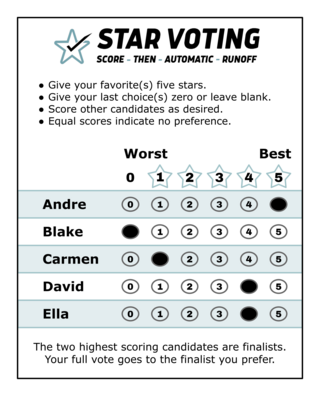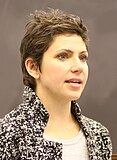
Approval voting is an electoral system in which voters can select any number of candidates instead of selecting only one.
Score voting or range voting is an electoral system for single-seat elections, in which voters give each candidate a score, the scores are added, and the candidate with the highest total is elected. It has been described by various other names including evaluative voting, utilitarian voting, interval measure voting, point-sum voting, ratings summation, 0-99 voting, and average voting. It is a type of cardinal voting electoral system that aims to approximate the utilitarian social choice rule.

The two-round system (TRS), also known as runoff voting, second ballot, or ballotage, is a voting method used to elect a single candidate, where voters cast a single vote for their preferred candidate. It generally ensures a majoritarian result, not a simple-plurality result as under first past the post. Under the two-round election system, the election process usually proceeds to a second round only if in the first round no candidate received an absolute majority of votes cast, or some other lower prescribed percentage. Under the two-round system, usually only the two candidates who received the most votes in the first round, or only those candidates who received above a prescribed proportion of the votes, are candidates in the second round. Other candidates are excluded from the second round.

Proposition 62 was a California ballot proposition on the November 2, 2004 ballot. It failed to pass with 5,119,155 (46.1%) votes in favor and 5,968,770 (53.9%) against.

FairVote is a 501(c)(3) organization that researches and advocates for electoral reform in the United States.
A nonpartisan blanket primary is a primary election in which all candidates for the same elected office run against each other at once, regardless of the political party. Partisan elections are, on the other hand, segregated by political party. Nonpartisan blanket primaries are slightly different from most other elections systems with two rounds/a runoff, also known as "jungle primaries" , in a few ways. The first round of a nonpartisan blanket primary is officially the "primary." Round two is the "general election." Round two must be held, even if one candidate receives a majority in the first round.
Instant-runoff voting (IRV) is a voting method used in single-seat elections with more than two candidates. Instead of voting only for a single candidate, voters in IRV elections can rank the candidates in order of preference. Ballots are initially counted for each elector's top choice, losing candidates are eliminated, and ballots for losing candidates are redistributed until one candidate is the top remaining choice of a majority of the voters. When the field is reduced to two, it has become an "instant runoff" that allows a comparison of the top two candidates head-to-head.
Electoral reform in the United States refers to efforts to change American elections and the electoral system used in the United States.
Electoral reform in Alaska refers to efforts to change the voting laws in this U.S. state. U.S. Senator John McCain and other Republicans endorsed a referendum to implement Instant Runoff Voting, after the conservative vote split between the Republican candidate and the Alaskan Independence Party candidate, allowing a Democrat to win the governorship. However, the League of Women Voters opposed it, citing the principle of one man, one vote, and the measure was defeated. Another issue is whether Alaska will join the National Popular Vote Interstate Compact and designate its three electors to the candidate winning the nationwide popular vote, rather than the winner of the state's vote. SB 138, a bill to do just that, was introduced in 2007, but was not approved.

Electoral reform in California refers to efforts to change election and voting laws in the U.S. state of California.

Electoral reform in Colorado refers to efforts to change the voting laws in the Centennial State.

Ranked-choice voting (RCV) can refer to one of several ranked voting methods used in some cities and states in the United States. The term is not strictly defined, but most often refers to instant-runoff voting (IRV) or single transferable vote (STV).
Instant-runoff voting (IRV), also known as plurality with elimination or plurality loser, is a ranked-choice voting system that modifies plurality by repeatedly eliminating the last-place winner until only one candidate is left. In the United Kingdom, it is generally called the alternative vote (AV). In the United States, IRV is often referred to as ranked-choice voting (RCV), by way of conflation with ranked voting systems in general.

The 2009 Burlington mayoral election was held in March 2009 for the city of Burlington, Vermont. This was the second mayoral election since the city's 2005 change to instant-runoff voting (IRV), after the 2006 mayoral election. In the 2009 election, incumbent Burlington mayor won reelection as a member of the Vermont Progressive Party, defeating Kurt Wright in the final round with 48% of the vote. The election created a controversy over several election pathologies, after Kiss was declared winner as a result of 750 votes cast against his candidacy, over the objections of the 54% of Burlington voters who had preferred Andy Montroll.

STAR voting is an electoral system for single-seat elections. The name stands for "Score then Automatic Runoff", referring to the fact that this system is a combination of score voting, to pick two finalists with the highest total scores, followed by an "automatic runoff" in which the finalist who is preferred on more ballots wins. It is a type of cardinal voting electoral system.

The Center for Election Science (CES) is an American 501(c)(3) organization that focuses on voter education and promoting election science. The organization promotes electoral systems favored by social choice theorists, primarily cardinal voting methods such as approval and score voting. They have their early roots in effective altruism.

Massachusetts Ranked-Choice Voting Initiative, also known as Question 2, was an initiative at the 2020 Massachusetts general election that would have changed primaries and elections in Massachusetts from plurality voting to ranked-choice voting (RCV) for all Massachusetts statewide offices, state legislative offices, federal congressional offices, and certain other offices beginning in 2022. RCV would not be extended to elections for president, county commissioner, or regional district school committee member. The initiative failed, with 54.8% of voters voting 'No' and 45.2% 'Yes'.

Mississippi state elections in 2020 were held on Tuesday, November 3, 2020. Its primaries were held on March 10, 2020, with runoffs taking place on June 23.

Alaska Measure 2 was a ballot initiative approved by voters in Alaska as part of the 2020 United States elections. The proposal switched Alaska's primary system to a non-partisan blanket primary. The top four candidates progress to the general election, which is conducted with ranked-choice voting. Voting for U.S. president will continue to utilize primaries based on political party, but ranked-choice voting will still be used in the general election. The initiative also requires additional disclosures of campaign financing.
A top-four primary or top-four ranked-choice voting is an election method using a nonpartisan blanket primary where up to four candidates, those with the most votes, advance from a first round of FPTP voting, regardless of the political party. The round two (general) election, held some weeks later, uses instant-runoff voting to confirm a winner among the top set of candidates.


















